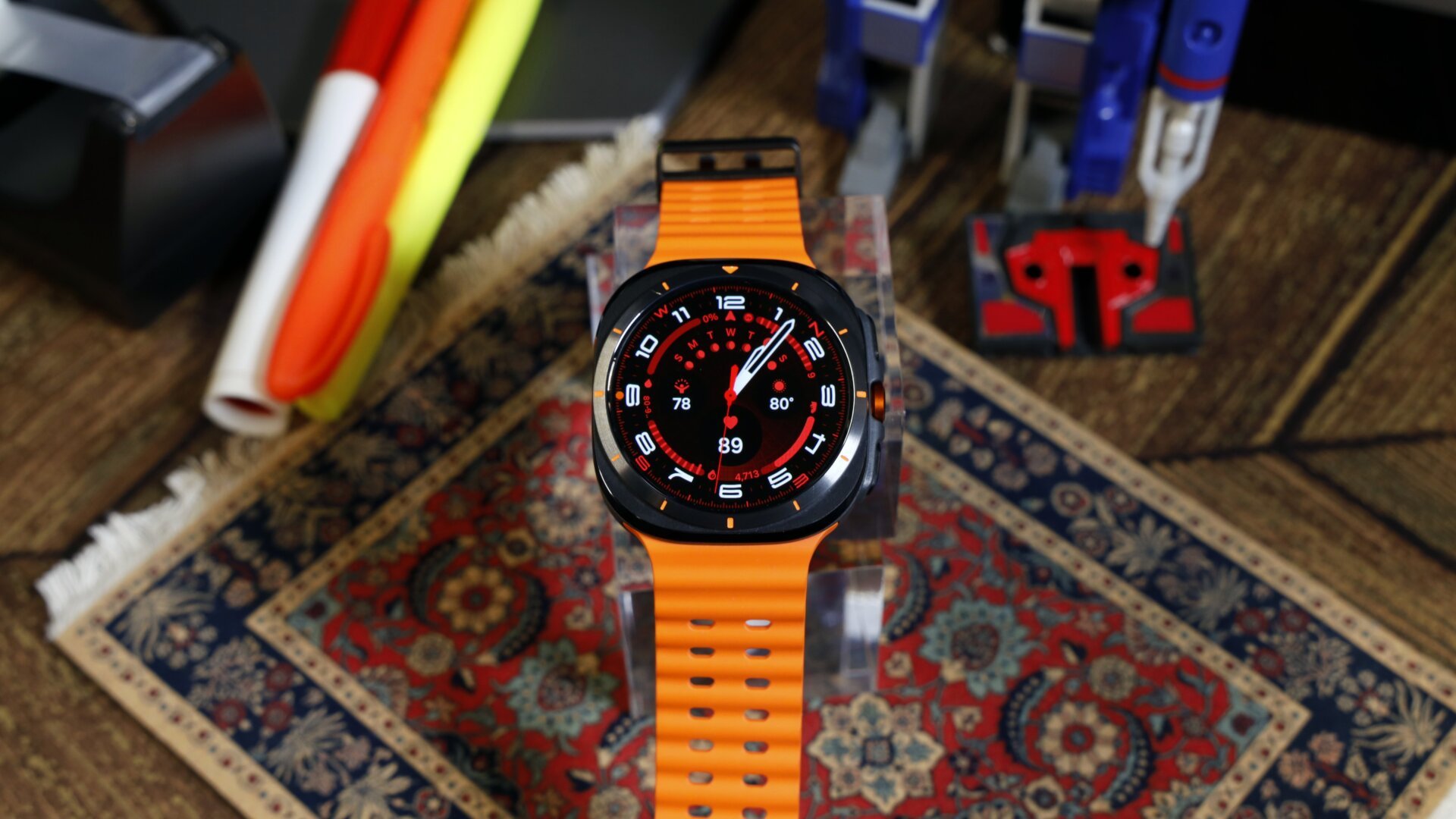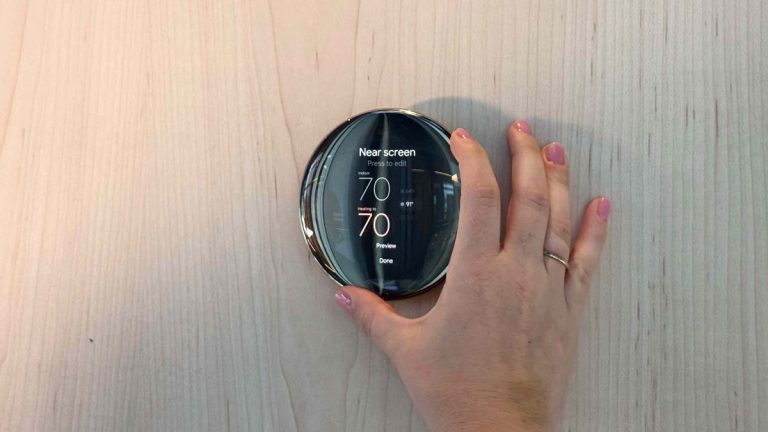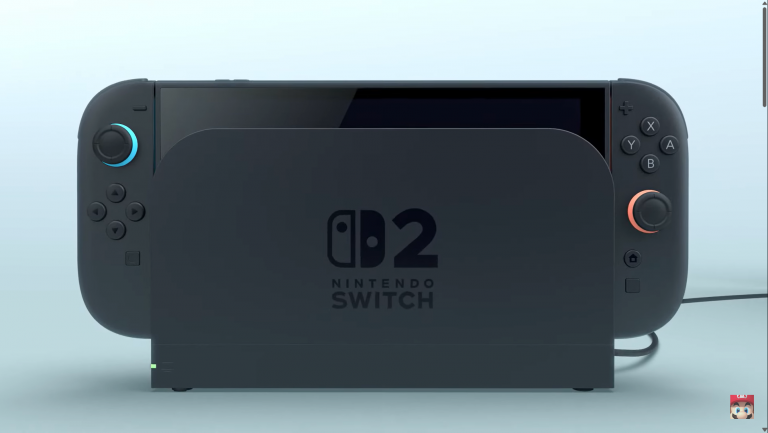Samsung Galaxy Watch Ultra Review

The Samsung Galaxy Watch Ultra is a lot of watch. At certain times when using it, I thought it may have been too much watch. As somebody who enjoys biking and hiking, I find Samsung’s most expensive wearable to be a useful, though overly talkative companion. It’s the kind of device for folks who are desperate to close their circles and don’t mind a watch that’s always in their face. Even after two weeks with the Ultra strapped to my wrist, I’m not sure I’ll ever be that kind of person.
Samsung Galaxy Watch Ultra
It’s a solidly-built watch whose giant display will please the statistic-obsessed athletes.
Pros
-
Two day battery life even doing workouts -
Detailed and customizable Ultra-exclusive watch faces -
Feels comfortable for long-term use
Cons
-
It’s a big, big watch -
Not too many exclusive features -
Could really use the Watch Classic’s rotating bezel
The $650 Galaxy Watch Ultra is a step up from the base $300 Galaxy Watch 7 in several ways, but it’s still a beefier version of its cheaper brother. It has a better battery, a more durable shell and screen, and far better water resistance, and it is rated for up to 100 meters under the waves. Additionally, it has several more tweaks to Samsung’s suite of WearOS 5 apps meant to offer more details about your cycling or running performance.
Naturally, the first thing you’ll compare the Galaxy Watch Ultra to is the Apple Watch Ultra 2, which is more than fair. Samsung named it to propose an Android alternative to Apple’s rugged and expensive sports watch. The Galaxy Watch Ultra is $650 compared to the Apple Watch Ultra’s $800, but Samsung boasts blood oxygen sensing features like sleep apnea tracking, something that’s not on the Apple Watch due to an ongoing patent kerfuffle with Masimo Inc.
Like the Apple Watch Ultra 2, this device will entice athletes with very specific features. These are the sort of capabilities I can’t test individually without suddenly throwing on a wetsuit and taking scuba lessons. I’m an active guy. I practice historical swordsmanship twice weekly and walk, bike, and hike whenever and wherever possible. Still, I’m not going to start training for a triathlon or aquathlon anytime soon.
But I can tell you what it’s like to dedicate so much of my wrist’s real estate to Samsung’s expensive sports watch. The device sits like a mountain on my arm, and the Marine silicon watch band is a little much if you’re merely taking a stroll around town. I’d suggest looking at the Trail or Peakform bands instead, though I haven’t tested either of those options. More than that, the rugged and durable Watch Ultra is made to hound you about your health data. I wouldn’t go as far as to call it a hypochondriac’s paradise. Still, with the dedicated sleep apnea detection and advanced glycation end products (AGE) tracking, it starts to feel overwhelming after your initial checkup with doctor Samsung.
I like the Ultra-exclusive watch face designs. I enjoy having so much data up-front in such a customizable way. And yet, I desperately wish Samsung included some analog control mechanism on this $650 watch. Even though a 47 mm display is big for a watch, it’s still relatively small for my fingers to operate alone. The Galaxy Watch Classic has that famed rotating bezel, and damn me if I miss its absence here. Samsung’s high-end sports watch also has a programmable “Quick Button” equivalent to Apple’s Action Button, but the Korean tech giant didn’t have a digital crown equivalent.
What’s here is still a very good sports watch. Its strong battery life lasts well past a full day and multiple workouts. If you want to dedicate your wrist to being your athletic activity center, you couldn’t do much better than the Watch Ultra.
Galaxy Watch Ultra Design and Display
Samsung calls its square body beneath the circular display its “cushion design.” I wouldn’t call the watch pillow-like, but it’s relatively comfortable. I never truly forgot I was wearing it, but I could fall asleep with it on as quickly as I could without it (which, to be fair, isn’t that easy for me without a watch). I could find a snug fit with the base and only wristband option that wasn’t too tight or loose.
It’s still a big watch. While the face is an already large 47mm, the chassis feels bigger than that. I have some rather average-sized wrists, and the Ultra takes most of that diameter. The watch is 12.1 mm thick, and it has managed to snag on shelves, door frames, and some towels while I do laundry. It’s a good thing it’s a rugged little guy, and the new Dynamic Lug band connectors kept it in place. I don’t imagine getting any less clumsy with it, even after several more weeks of use.
The Apple Watch Ultra 2 is a 49mm watch face, yet it feels smaller once you get it on your wrist. If there’s one thing Samsung should have stolen from Apple, it’s the digital crown. This big, expensive watch could have stolen the rotating bezel that’s such a beloved part of the Galaxy Watch Classic. The rim even looks like it should rotate. Instead, it’s stuck to touch controls. Even with a large watch face and improved navigation between Tiles in WearOS 5, it’s still not as clean as a physical control. It would have made the Galaxy Watch Ultra stand apart even more from the Galaxy Watch 7, mainly because there’s no updated Classic this year.
At the very least, it looks like the part. I like the orange and titanium gray colorway, and you can customize the digital watch face in a variety of ways. I kept the standard Ultra Analog but switched up the colors for classy red on black. You can also modify the eight different complications around the face, and there’s a dizzying number of options. If you don’t want your typical watch face but still demand a lot of information upfront, the Ultra Info Board is also very comprehensive.
The exclusive night mode is also very attractive in its deep neon red. Eventually, you can get used to its size, and the bright screen goes a long way toward that end. The automatic brightness detection was good enough for direct sunlight or dimly lit rooms, and it was solid.
Galaxy Watch Ultra Software and Usability

Samsung’s most expensive watch shares much of the same software as the Watch 7, though there are a few upgrades to how the watch handles different workouts and health tracking. Plus, it now has a handy programmable Quick Button. I kept it on the default to bring up workouts, but you can also change it to bring up other functions. I got more mileage out of that than the pinch gesture, which never seemed to work for me in the few places you can use it.
Let’s get those exclusives out of the way. I’m a pretty active person, but that’s not something I require in my day-to-day life. I do enjoy the odd day of cycling when I can manage it. The Ultra supports “Functional Threshold Power” tracking based on your heart rate. It measures the power a rider can maintain for peak performance over an hour. That also requires an extra power meter compatible with a Galaxy phone. Those cost hundreds or even thousands of dollars. You’ll get your speed, incline, and other cycling metrics with Samsung Health on both the Ultra and Watch 7. That’s more than enough for most casual bikers.
There’s also an Ultra-specific tile for multi-sports. This lets you set it up for when you’re training to run, bike, and swim in quick succession. The rest you can get on the Ultra is also on the Watch 7. That includes a new AGE index (still in a “Labs” beta in the Samsung Health app) via a rebuilt health sensor array, more accurate GPS tracking, and blood oxygen sensing for sleep apnea.
Samsung makes it clear when using the watch that none of this data is meant to substitute a full checkup with a health professional. The sleep apnea feature requires you to spend two nights with it on, and if the watch detects any blood oxygen issues, it will simply tell you to see a doctor. The same goes for heart rate or ECG monitoring.
There are times when the watch is slightly off the mark. The Ultra once detected I woke up at 7:10 a.m. That would have been a great night’s sleep for me, but I know I was fully awake before 6 a.m., or at least when I was cognizant enough to check the time on my phone (obviously bleary enough to forget to check the time on the watch I was wearing). I don’t know how much that impacts my sleep score, though Samsung Health routinely told me I was fair to good on my energy score. I don’t feel like a “good” or “fair” most days, but perhaps the only way to feel bright-eyed and bushy-tailed is to reach the fabled 100 score.
The GPS still isn’t perfect for city settings. That dual-band GPS is meant to track your whereabouts better. It did a very good job showing my biking courses, but that was along some main thoroughfares in Brooklyn. I tracked a few walks in Manhattan, and the Samsung Health app seemed to show me phasing through buildings. GPS is notoriously hard in urban environments, but I wouldn’t say the new watches are a true cut above past models.
Finally, you have a few additions that come from the update to WatchOS 5. This version of the Android watch is supposed to be faster, and while I wouldn’t say the watch felt snappy, I never had any lag or issues with supported apps. That Tiles interface is still imperfect. It lacks a quick ability to reposition each tile, and my watch was limited to 15 widgets even though I know it could handle more. You can use your finger to rotate around the screen to select a tile, but if this thing had a physical bezel, it would be that much easier.
Galaxy Watch Ultra Battery Life and Durability

If there’s no specific feature that might entice you to buy the bigger watch, you would probably get the Ultra for the better battery life. It houses a 590 mAh battery compared to the 300 mAh or 425 mAh batteries on the Watch 7 models. After using it, I can say that battery size makes a big difference in longevity.
After a few days with the watch, after its battery was fully calibrated, I could run it for nearly 46 hours, go through two workout sessions in one day, and still have just enough juice to check the time before plugging it in and going to bed. That was all without needing to turn on regular or exercise power-saving mode.
After a night’s rest, I would wake up and find that it had only lost about 10% of battery life, even when it was testing for sleep apnea. I would still suggest taking the charging pad with you if you don’t think you’ll be home for a while. Compared to past Galaxy watches, there’s no more reverse wireless charging from a Samsung phone. The company claims this is due to the redesigned BioActive Sensor, so it no longer sits flat. I initially didn’t think it would be an issue for me. That was until I forgot my charging pad at the office, and my watch was on its last legs.
At the very least, I didn’t need to worry about the watch overheating, even during this period of severe heat. Even when the sun was baking the streets and frying me like an egg on the sidewalk, the watch and my wrist didn’t get any warmer than the ambient environment. The watch has an operating temperature between -4 degrees and 131 degrees Fahrenheit. I haven’t taken the watch into Death Valley, and I probably never will, but it worked as well as it should for my purposes.
Verdict

More than any watch I’ve used, the Galaxy Watch Ultra made me feel like a cyborg, always plugged in, whether during my workouts, training or just walking around. I couldn’t just wear the watch and forget it was there. It buzzes routinely to tell me to stand up from my desk. It gets caught on my clothes when I put them on. Its bright display glows with puppy-like glee after I pay it a bare glance.
I appreciate that it’s still slightly cheaper than the Apple Watch Ultra, but that doesn’t mean it’s cheap. It still costs more than twice as much as the baseline Watch 7, and I wouldn’t say any of the features are so defining that it makes it worth the extra $350. The fellow big-screen OnePlus Watch 2R boasts the same multi-day battery life as Samsung’s Ultra, though it’s not going to have nearly as many health tracking features.
But then again, I would prefer the Ultra over the 7 simply because if I’m hiking, I won’t have to worry about my watch dying on me as I huff it through the woods. I like the Ultra watch faces and all the little complications far more than you can get on the cheaper devices. If the Ultra had the classic’s rotating bezel, it would be an easy recommendation for those who can afford it.
It’s a watch that will take over your wrist and—if you let it—your life. If that’s what you’re after, then the Ultra and its massive watch face fits the bill.
Source: gizmodo.com






